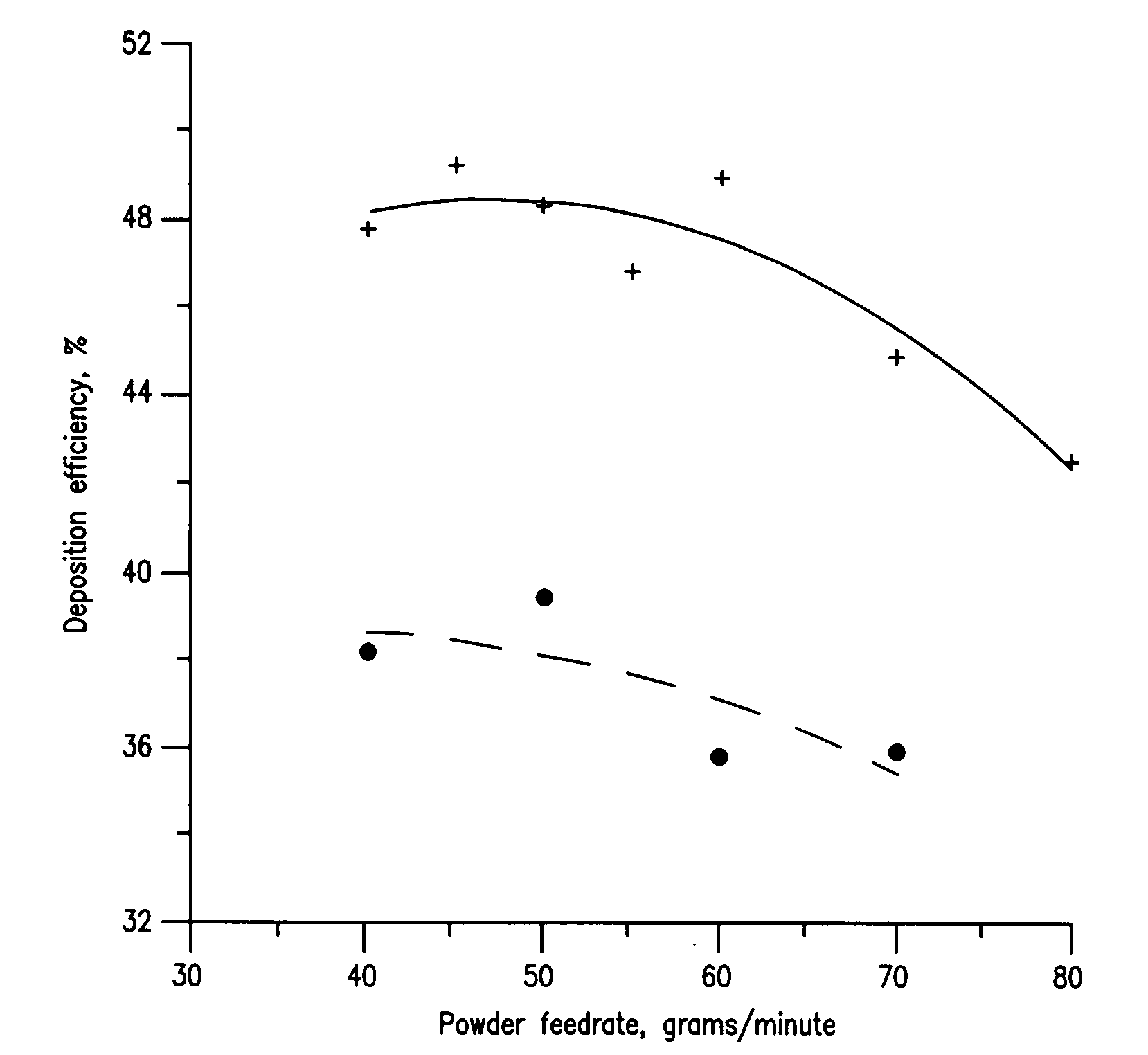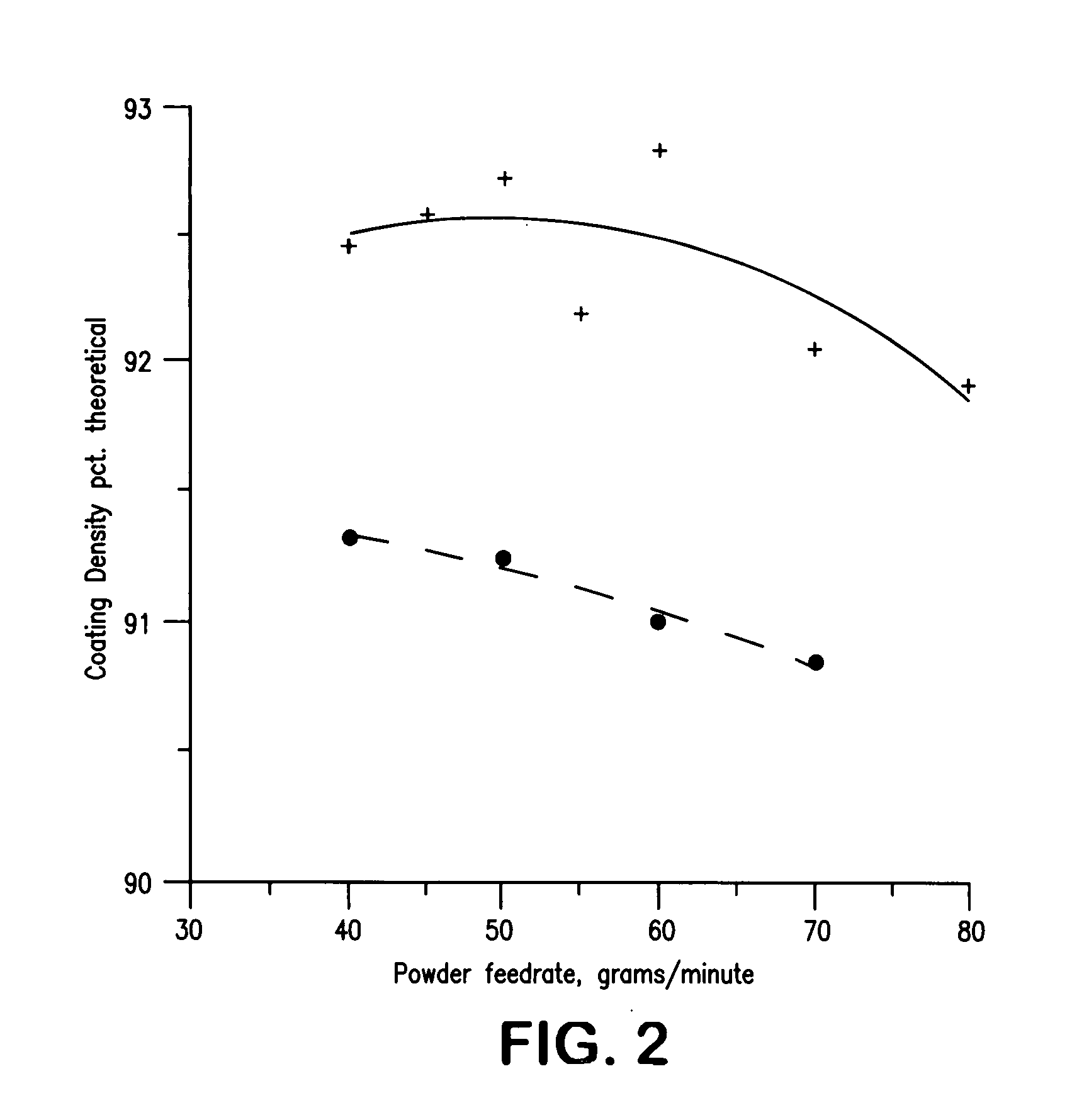Blade tip coatings
a coating and blade technology, applied in the field of blades, can solve the problems of affecting the performance of the blade, and the possibility of a rub between the tip and the seal,
- Summary
- Abstract
- Description
- Claims
- Application Information
AI Technical Summary
Benefits of technology
Problems solved by technology
Method used
Image
Examples
example 1
[0077]Table A below shows the composition of a conventional yttria stabilized zirconia powder (i.e., Powder B) and a high purity yttria stabilized zirconia powder (i.e., Powder A). The composition range for the conventional fused and crushed powder was taken from its specifications for maximum allowed values, with actual lot analyses typically about 10-50 percent of the maximum. The new high purity powder compositions were taken from five actual lots, giving only the maximum value analyzed for any lot. Of the components of yttria stabilized zirconia, yttria is meant to be in the range of 6.5 to 8 weight percent, in order to stabilize the structure in the tetragonal phase. The purpose of hafnia is unknown, but typically is always present at about 1.5 weight percent. Table A shows that Powder A is significantly more pure than Powder B in the un-wanted impurities of alumina, silica, iron oxide, titania and magnesia.
TABLE APowder Compositions(Weight percent)Powder BPowder AZirconiaBalan...
example 2
[0082]This example was conducted with a Praxair model 1108 plasma torch, although parameters could be found for making the desired coating with other torches, such as with the Praxair detonation gun or Praxair super detonation gun, the latter being of even higher particle velocity and temperature. In the Praxair model 1108 plasma torch, the plasma is developed in a flow of argon plus hydrogen gas by an electrical arc discharged between an electrode and an anode. The powder is carried in another argon stream and injected upstream of the arc, benefiting from a full transmit though the arc zone. These flows and electrical currents can be varied to determine their effects on coating deposition rates.
[0083]Table C shows the powders used in this coating deposition. Powder C is significantly more pure than Powder D in the unwanted impurities of alumina, silica, iron oxide, titania, calcia, magnesia and other oxides.
TABLE CPowder Compositions(Weight percent)Powder DPowder CZirconiaBalanceBa...
example 3
[0087]Different torch gas flow and power conditions were evaluated. In a designed experiment, total gas flows of 176 to 264 cubic feet per hour and torch currents of 160 to 190 amperes (the KW of energy varied from 11.7 to 14.8) were tested. It was found that reducing the total gas flows to 176 cubic feet per hour at 14.3 KW gave the highest deposition efficiency, and this was 10 efficiency points higher than shown on FIG. 1 for Powder C. It is believed that these conditions obtain higher melting fractions of the powder by slowing the particles down somewhat as they transmit the arc zone and by increasing the available enthalpy for melting. It may not be quite that simple since the highest KW or enthalpy condition did not giver the highest deposition efficiency. Multiple correlation analysis of the deposition efficiency results show an expected increase with torch current and a decrease with increasing total gas flow, but also a possible interaction between the two variables.
[0088]T...
PUM
| Property | Measurement | Unit |
|---|---|---|
| Temperature | aaaaa | aaaaa |
| Temperature | aaaaa | aaaaa |
| Temperature | aaaaa | aaaaa |
Abstract
Description
Claims
Application Information
 Login to View More
Login to View More - R&D
- Intellectual Property
- Life Sciences
- Materials
- Tech Scout
- Unparalleled Data Quality
- Higher Quality Content
- 60% Fewer Hallucinations
Browse by: Latest US Patents, China's latest patents, Technical Efficacy Thesaurus, Application Domain, Technology Topic, Popular Technical Reports.
© 2025 PatSnap. All rights reserved.Legal|Privacy policy|Modern Slavery Act Transparency Statement|Sitemap|About US| Contact US: help@patsnap.com



